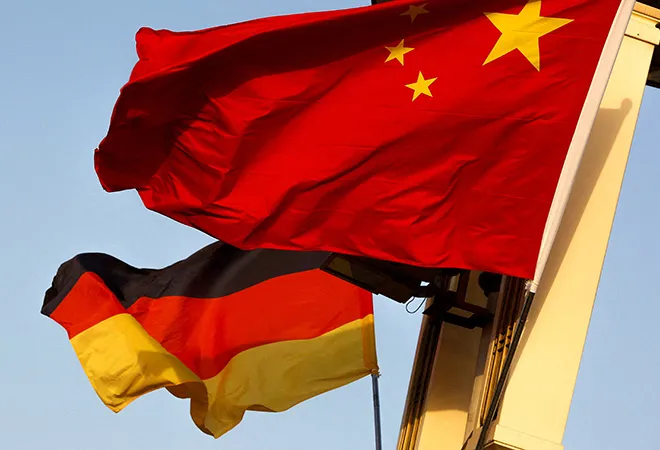
Germany’s China policy is often lamented as one
“at sea, drifting without an anchor”. This may finally change after the recent release of
Germany’s China strategy, which attempts to recalibrate relations with its top trading partner. The 64-page document follows
Germany’s National Security Strategy released in June, outlining a revamp of the country’s security and economic outlook in an increasingly volatile geopolitical context.
The China strategy reiterates the familiar balancing act of viewing China through the trinity of “competition, partner, systemic rival” although it does recognise that the rival elements have gained greater prominence now. The Russia-Ukraine conflict spurred a
Zeitenwende or turning point in Germany, enabling the country to rethink its previous policies of engagement, which enabled lopsided dependencies on authoritarian states such as Russia and China. As German Foreign Minister Annalena Baerbock
warned, Germany cannot afford to “pay more than 200 billion euros to get out of a dependency” again.
The Russia-Ukraine conflict spurred a Zeitenwende or turning point in Germany, enabling the country to rethink its previous policies of engagement, which enabled lopsided dependencies on authoritarian states such as Russia and China.
China’s aggressive actions in the South China Sea, increasing tensions in the Taiwan Strait, domestic repression and human rights violations, and Beijing's deepening partnership with Moscow have also served as factors in this fundamental rethink. “China has changed. As a result of this and China’s political decisions, we need to change our approach to China,”
reads the document.
‘De-risking’ is the buzzword
The China strategy devotes a lot of attention to
‘de-risking’ from China—an issue at the forefront of debates in national capitals in Europe as well as at the European Union (EU) level in Brussels. The document
cautions that “China strives to create economic and technological dependencies in order to then use them to achieve political goals and interests.” In this context, de-risking involves diversifying supply chains and trade partners and reducing dependencies in critical sectors such as raw materials and technologies, and in areas of semiconductors, pharmaceuticals, and batteries, amongst others.
Diversifying away from China necessitates closer economic ties with other more ‘like-minded’ partners. In this regard, the document
focuses on “global partnerships” in the Indo-Pacific region and with the United States (US), but also in Latin America and Africa. Long considered the weakest link in the EU’s revamped approach to China, the strategy reiterates that the German approach is embedded within the wider EU framework and also aims to expand Germany’s security cooperation with partners in the Indo-Pacific. However, given Berlin’s inability to live up to its increased defence spending
pledges yet, its potential to contribute to security in the Indo-Pacific is questionable.
Long considered the weakest link in the EU’s revamped approach to China, the strategy reiterates that the German approach is embedded within the wider EU framework and also aims to expand Germany’s security cooperation with partners in the Indo-Pacific.
Big talk, small stick?
Despite all its talk, the document does not lay out specific incentives nor binding requirements for companies to de-risk or diversify away from China. Neither does it compensate companies for diversifying or penalise them for not doing so. In this manner, it more or less leaves the task or choice of de-risking to companies with a limited role for the government. This begs the obvious question of whether industry will follow through on these policies given how German companies, particularly those in the automobile sector, are heavily dependent on the Chinese market for their profits. China
accounts for the sale of over a third of all vehicles produced by Mercedes Benz and BMW, and German carmakers are now facing
competition from local Chinese carmakers such as Nio. Nothing captures this situation better than the
remarks of an unnamed German official who said, “The cow is still giving milk. We are not ready to slaughter it yet.”
The strategy also explicitly states that it would not bail out companies in the event of an escalation of geopolitical tensions such as in the Taiwan Strait. Besides, certain German companies are actually increasing their investments in China. German chemicals company BASF, for whom China comprises 15 percent of yearly sales,
intends to invest 10 billion euros by 2030 in a facility in Zhanjiang, Southern China. The document also leaves out proposals to monitor progress on de-risking or diversification. It aims to enact export controls and scrutinise both inbound and outbound investments in China to protect transfers of sensitive technologies amidst wider security and human rights concerns, but it does not address how this would be done. A more potent
initial draft of the strategy leaked in November last year, which included stress tests for companies to identify risks and manage resilience relating to China. But disagreements within the traffic-light coalition, with Chancellor Olaf Scholz’s Social Democrats’ more conciliatory approach towards China and Baerbock’s Greens’ more hawkish stance, led to the scrapping of these provisions in the final draft. In the absence of these important specifics, the document seems to merely pile rhetorical pressure on companies.
Despite talk of diversification, German companies last year invested a record 11.5 billion euros in China and bilateral trade stood at almost 300 billion euros.
While the strategy talks of protecting critical infrastructure, just last year Scholz
allowed Chinese state-owned company COSCO to invest in the Hamburg port terminal despite strong opposition at home. Despite talk of diversification, German companies last year
invested a record 11.5 billion euros in China and
bilateral trade stood at almost 300 billion euros. Moreover, a lot of 5G networks in Germany are
built using Huawei hardware. This year, Scholz laid out the red carpet for Chinese Premier Li Qiang in the latter’s first international trip, where, besides the inter-governmental consultations, the visit also included
meetings with top German CEOs. However, there are signs of a changed approach such as the coalition’s
decision to block Chinese bids for stakes in two German semiconductor firms Elmos and ERS Electronic.
Will actions follow words?
Additional factors such as a weakening German economy, the increasing popularity of the far-right Alternative for Germany (AfD) threatening Scholz’s grip on power, and anxiety surrounding the 2024 American elections will further complicate the balancing act of getting tough on China while not jeopardising businesses and political power in the process. Although a Pew survey last year
demonstrated that 74 percent of the German public viewed China negatively, this sentiment has traditionally failed to translate into policy both at the government and industry levels.
The strategy does signal a fundamental shift in the way Berlin is thinking about and approaching its relationship with China.
There are also important trade-offs that the strategy does not address while talking about reducing critical dependencies. For instance, it does not address the key question of where Germany would get its supplies of critical raw materials as well as technologies such as wind turbines and solar panels—both of which largely come from China and are necessary for Germany’s green transition.
Yet, despite its shortcomings such as its ambiguity on policy measures, the strategy is resolute in its caricature of China and marks the formal end of
Wandel durch Handel—the Merkel-era policy of “change through trade,” which was based on the premise that economic engagement would result in a more democratic and liberal China. The strategy does signal a fundamental shift in the way Berlin is thinking about and approaching its relationship with China. Whether actions will follow words in Europe’s economic powerhouse remains to be seen.
Shairee Malhotra is an Associate Fellow with the Strategic Studies Programme at the Observer Research Foundation.
The views expressed above belong to the author(s). ORF research and analyses now available on Telegram! Click here to access our curated content — blogs, longforms and interviews.



 Germany’s China policy is often lamented as one
Germany’s China policy is often lamented as one  PREV
PREV


